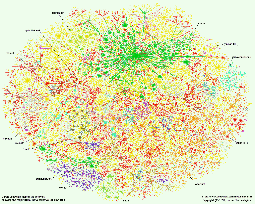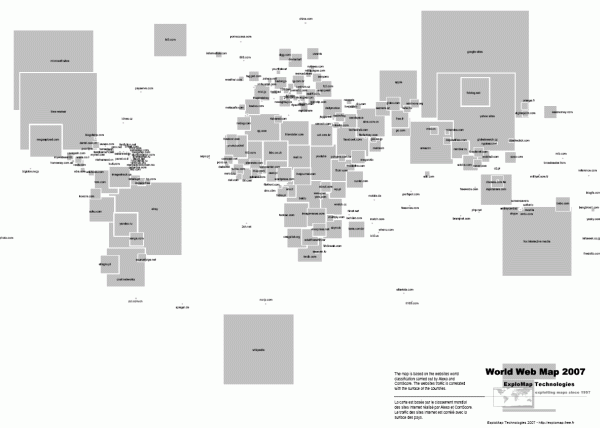Yesterday I saw a new incredible Internet Map (or better infographic) made by Teleography 
After having seen that last map, I thought it might be fun to have a post showing various kind of attempts to creat Internet Map since its start.
My first contacts with Internet Map is quite old since it started in 1999. This map has been made by Cheswick from Bell Labs and he created the Internet Mapping Project (gallery).

Roughly, it shows connectivity between ISPs in the world.
But since then, some other efforts to map the Internet have been made like by Opte

CAIDA is probably the best in its class with great topology representations (Main gallery, Walrus gallery)
One question people might ask themselves is why would we bother about visually representing the internet? Well, there are a lot of bits to that answer. In 2 words, there is no best way to try to understand than by visually stating a problem. It means that we understand better the Internet once it has been graphically represented. Of course, every different representation brings its own bits of interpretation and enables deeper and further understanding.
But also, a graph is nothing more than a mathematical representation and as such CAIDA has been a source of information for researchers worldwide by providing data sets of these representations which helped to think on the Internet represented as a graph (or better as a variety of graphes).
And finally, better understanding or better characterizing Internet structures/behaviors has been the basis for improvements of it.
Note to mention that there are multiple ways to represent the Internet facets.
A first interesting view has been created by World Web Maps. They put web sites on top of the World Map correlating web sites popularity with country sizes.
Facebook made another interesting map. They create a friendship world map showing geographical connection between people.

There had been an effort to create an Atlas of Cyberspaces. This project gathered a lot of maps of all sorts though it seems dead now.
So, to end this post, I guess we should thank people having spent their time to graphically represent the Internet in all of its forms. They all helped getting a better one for today. And in case, you're aware of some other forms of Internet representations I've not mentioned in this post, please share them!

After having seen that last map, I thought it might be fun to have a post showing various kind of attempts to creat Internet Map since its start.
My first contacts with Internet Map is quite old since it started in 1999. This map has been made by Cheswick from Bell Labs and he created the Internet Mapping Project (gallery).

Roughly, it shows connectivity between ISPs in the world.
But since then, some other efforts to map the Internet have been made like by Opte

CAIDA is probably the best in its class with great topology representations (Main gallery, Walrus gallery)

One question people might ask themselves is why would we bother about visually representing the internet? Well, there are a lot of bits to that answer. In 2 words, there is no best way to try to understand than by visually stating a problem. It means that we understand better the Internet once it has been graphically represented. Of course, every different representation brings its own bits of interpretation and enables deeper and further understanding.
But also, a graph is nothing more than a mathematical representation and as such CAIDA has been a source of information for researchers worldwide by providing data sets of these representations which helped to think on the Internet represented as a graph (or better as a variety of graphes).
And finally, better understanding or better characterizing Internet structures/behaviors has been the basis for improvements of it.
Note to mention that there are multiple ways to represent the Internet facets.
A first interesting view has been created by World Web Maps. They put web sites on top of the World Map correlating web sites popularity with country sizes.

Facebook made another interesting map. They create a friendship world map showing geographical connection between people.

There had been an effort to create an Atlas of Cyberspaces. This project gathered a lot of maps of all sorts though it seems dead now.
So, to end this post, I guess we should thank people having spent their time to graphically represent the Internet in all of its forms. They all helped getting a better one for today. And in case, you're aware of some other forms of Internet representations I've not mentioned in this post, please share them!
No comments:
Post a Comment